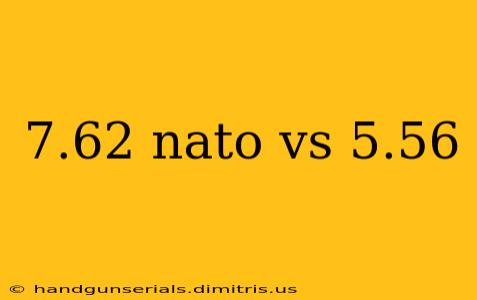The choice between 7.62 NATO and 5.56 NATO ammunition is a frequent debate among firearms enthusiasts, military strategists, and even casual shooters. Both calibers have a rich history and continue to be deployed globally, but their characteristics differ significantly, leading to distinct advantages and disadvantages in various applications. This in-depth comparison will explore the key differences between these two popular rounds, helping you understand their strengths and weaknesses.
Ballistics: A Tale of Two Trajectories
The most significant difference between 7.62 NATO (.308 Winchester) and 5.56 NATO (.223 Remington) lies in their ballistics. 7.62 NATO boasts a considerably heavier bullet, resulting in:
- Greater stopping power: The larger, heavier bullet transfers more energy upon impact, leading to a higher likelihood of incapacitating a target. This makes it particularly effective at longer ranges.
- Longer effective range: Its higher mass and ballistic coefficient mean it retains velocity and accuracy over longer distances than 5.56 NATO.
- Steeper trajectory: Due to its heavier weight and higher drag, 7.62 NATO follows a more pronounced ballistic arc, requiring more precise aiming at longer ranges.
- More recoil: The increased momentum of the heavier bullet translates to greater recoil, potentially affecting accuracy and shooter comfort, especially for less experienced users.
Conversely, 5.56 NATO offers:
- Lighter recoil: The smaller bullet results in significantly less recoil, allowing for faster follow-up shots and improved control, particularly during rapid fire.
- Faster rate of fire: Lower recoil contributes to a higher rate of fire, beneficial in close-quarters combat scenarios.
- Flatter trajectory: The lighter bullet experiences less drag, resulting in a flatter trajectory at shorter to medium ranges. This simplifies aiming and target acquisition.
- Higher magazine capacity: Smaller cartridges allow for higher capacity magazines, giving the shooter more ammunition before reloading.
Weaponry and Applications
The choice between these calibers often dictates the type of weapon system employed. 7.62 NATO is commonly found in:
- Designated marksman rifles (DMRs): The caliber's accuracy and stopping power at longer ranges make it ideal for DMRs.
- Battle rifles: These weapons often prioritize power and range over rate of fire.
- Sniper rifles: Many sniper rifles utilize 7.62 NATO for its precision and effectiveness at extreme distances.
5.56 NATO, on the other hand, is predominantly used in:
- Assault rifles: These weapons prioritize maneuverability, rate of fire, and control in close to medium-range engagements.
- Submachine guns (SMGs): While some SMGs utilize larger calibers, many are chambered in 5.56 NATO variants.
- Personal defense weapons (PDWs): These compact weapons leverage the 5.56 NATO's manageable recoil and high capacity magazines.
Cost and Availability
The cost of ammunition can also play a role in the decision-making process. Generally, 5.56 NATO ammunition is more readily available and often cheaper than 7.62 NATO ammunition. This cost difference can be significant, especially for users who require large quantities of ammunition for training or practice.
Conclusion: The Right Tool for the Job
Ultimately, the choice between 7.62 NATO and 5.56 NATO depends heavily on the intended application. There isn't a universally "better" caliber; each excels in different contexts. 7.62 NATO prioritizes stopping power and effective range, while 5.56 NATO emphasizes manageable recoil, higher rate of fire, and greater ammunition capacity. Understanding these core differences is crucial for making an informed decision based on individual needs and preferences. Consider the intended use, the distance of engagement, and the user's experience level when choosing between these two powerful calibers.

